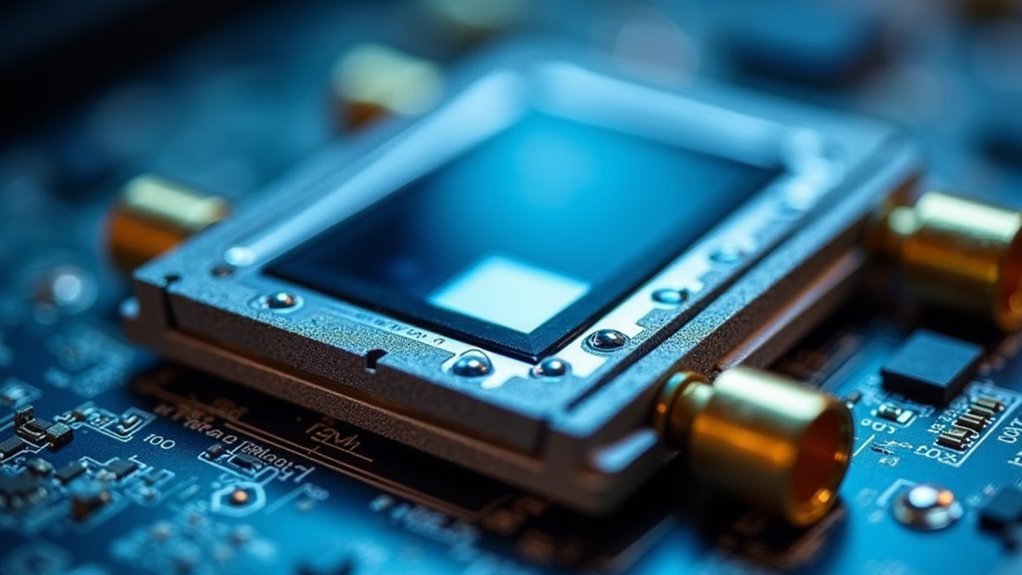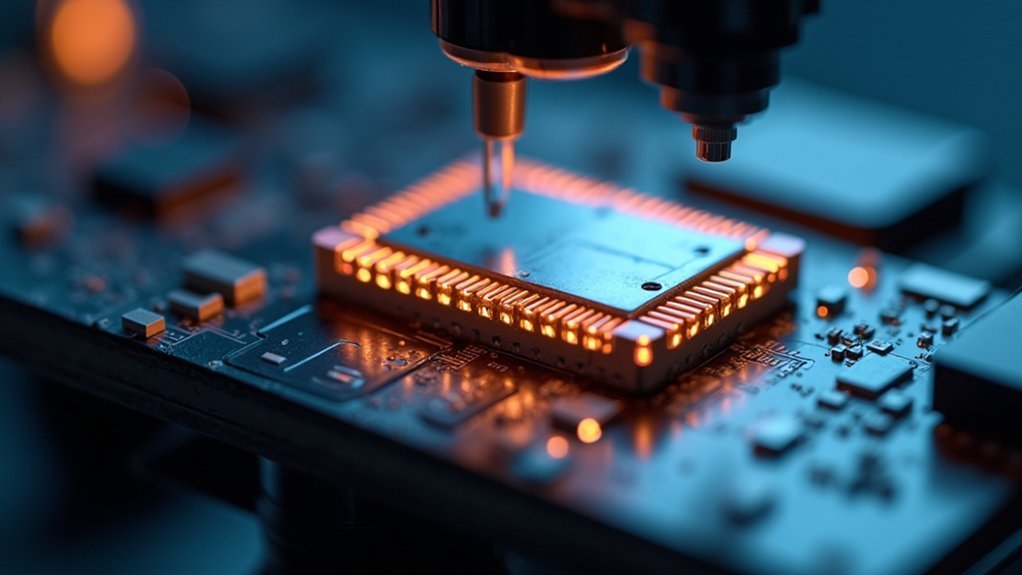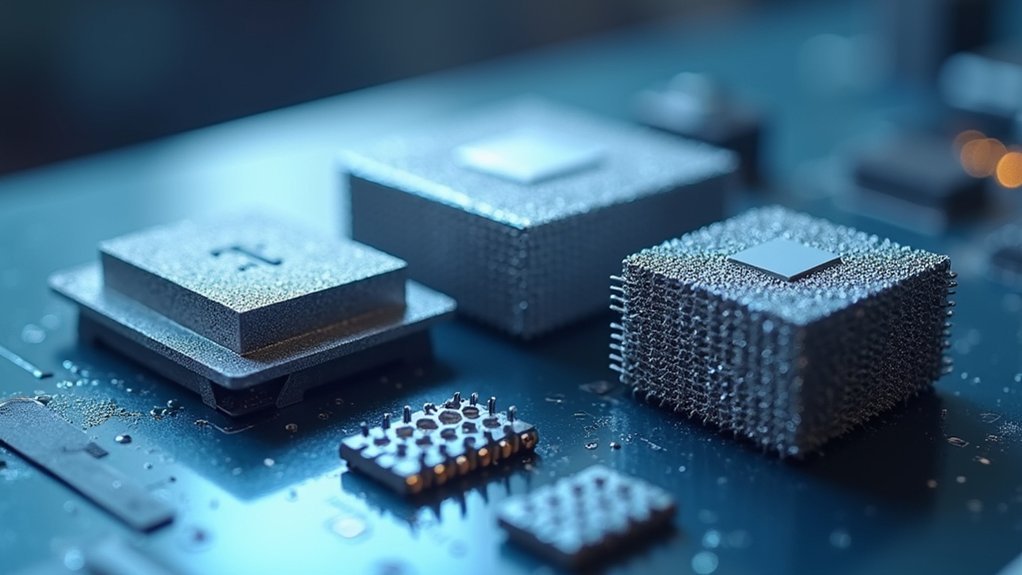The top three thermoelectric solutions for camera sensor cooling are: 1) Laird’s HiTemp ET Series, which provides temperature differentials up to 83°C for high-resolution microscopy, 2) Temperature-controlled sensor arrays that can reduce thermal noise to as low as 1 electron rms at -30°C, and 3) Compact HiTemp ETX coolers for space-constrained applications. These active cooling systems can lower your sensor temperature by approximately 30°C, dramatically reducing dark noise and hot pixels. Discover how these solutions enhance your imaging quality below.
Peltier-Based Active Cooling Systems for High-Resolution Microscopy

While standard camera sensors operate adequately at room temperature, high-resolution microscopy demands superior thermal management. Peltier coolers provide precise temperature control with differentials up to 83°C, considerably reducing thermal noise in microscopy applications.
The HiTemp ET Series thermoelectric coolers from Laird Thermal Systems are specifically engineered to prevent performance degradation in high-temperature environments, ensuring your CMOS sensors remain reliable during extended use.
You’ll achieve deeper cooling that reduces dark noise and hot pixel occurrences, enhancing image clarity.
These active cooling systems can lower device temperatures by approximately 30°C, markedly improving your high-resolution imaging results.
With over 50 models available in various form factors and power requirements, you’ll find options perfectly suited to your specific microscopy setup’s thermal management needs.
Temperature-Controlled Sensor Arrays for Scientific Imaging
Scientific imaging applications demand even greater cooling efficiency than standard microscopy systems. When you’re working with temperature-controlled sensor arrays in sCMOS cameras, thermal noise becomes a critical factor. Effective cooling solutions can reduce the noise floor to as low as 1 electron rms at -30°C, greatly improving image resolution.
Thermoelectric coolers (TECs) offer precise temperature control for your CMOS sensors, preventing dark noise from compromising image quality. Products like Laird Thermal Systems’ HiTemp ET Series achieve impressive temperature differentials of up to 83°C, essential for maintaining peak sensor performance below thermal limits.
You’ll find that implementing spot cooling techniques considerably reduces hot pixel blemishes, enhancing quantitative imaging accuracy. For scientific research requiring pristine data collection, proper thermoelectric management guarantees your sensor arrays deliver consistently reliable results.
Compact Thermoelectric Solutions for Advanced Microscope Cameras

As microscope cameras continue to shrink in size, compact thermoelectric coolers have become essential for maintaining image clarity and sensor performance.
The HiTemp ETX Series from Laird offers precise temperature control in environments up to 150°C, achieving an impressive 83°C temperature differential to reduce thermal noise in your imaging systems.
You’ll find over 50 models with varied heat pumping capacities and form factors, perfect for space-constrained setups.
These active cooling solutions effectively mitigate dark noise and hot pixel occurrences in CMOS sensors, dramatically enhancing microscopy imaging resolution.
The advanced thermoelectric materials used in these compact systems improve cooling capacity by up to 10%, ensuring reliable operation even in high-demand applications like super-resolution microscopy where image quality is paramount.
Frequently Asked Questions
What Is the Maximum Temperature Difference for a Thermoelectric Cooler?
You’ll find that high-performance thermoelectric coolers can achieve a maximum temperature differential (ΔT) of up to 83°C. This significant cooling capacity lets you maintain ideal operating conditions in demanding environments where heat management is critical.
What Is the Lowest Temperature for Thermoelectric Cooling?
Thermoelectric coolers can reach temperatures as low as -30°C depending on ambient conditions. You’ll find that multi-stage TECs can achieve even lower temperatures, though efficiency decreases as you approach these extreme cooling limits.
How Do I Make My Thermoelectric Cooler Colder?
To make your thermoelectric cooler colder, guarantee perfect thermal contact, use quality materials, improve heat dissipation with liquid cooling, operate in cooler environments, and optimize power input to achieve maximum temperature differential.
How Effective Is Thermoelectric Cooler?
Thermoelectric coolers are quite effective. You’ll get temperature differences up to 83°C, with practical cooling of about 30°C. They’re especially valuable for reducing thermal noise in sensitive electronics and improving performance in demanding applications.
In Summary
You’ve explored top thermoelectric solutions that revolutionize camera sensor performance. Whether you’re using Peltier-based cooling for high-resolution microscopy, temperature-controlled arrays for scientific imaging, or compact thermoelectric modules for advanced cameras, these technologies guarantee peak image quality and sensor longevity. By implementing these solutions, you’ll achieve consistent results even in challenging thermal environments while extending your equipment’s operational life.





Leave a Reply